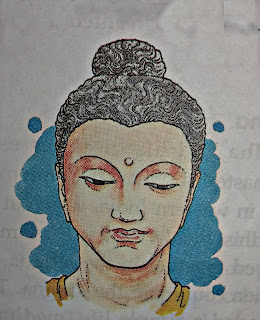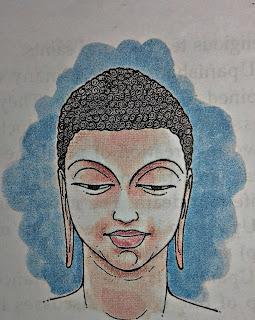Is Buddhism a religion.
Around the sixth century BCE, that is, about 2500 years ago, two great men were born in india. They were Gautam Buddha and Vardhamana Mahavira. Their teachings gave birth to two religions - Buddhist and Jainism.
BUDDHISM
Buddhism is named after Gautam Buddha. His real name was Siddhartha. He was brought into the world at Lumbini. His father was the chief of the Shakya clan. Siddhartha had a comfortable life as a prince. Yet, he was not happy.
Guest for truth
Prince Siddhartha is believed to have seen four sights which left a deep impact on him. He saw a very old man, then a sik man and finally a dead body. These sights left him disturbed and uneasy. He than saw an ascetic who appeared unaffected by the pain, sorrow and misery around him. Siddhartha decided to search for answers to the mystery of life and death. He wanted to find a solution to the suffering of mankind.
Siddhartha ventured out from home to look for information and the genuine importance of life. For six years, he wandered from place to place. He learnt to meditate. He sat beneath a pipal tree in Gaya and began to meditate. After many days of intense meditation, he discovered supreme knowledge and attained enlightenment. He comprehended the reason why the world is brimming with misery and how ought to be dealt with conquer it. He thus became the Buddha, the enlightened or the Awakened or the Wise one. The pipal tree under which he attained enlightenment, came to be known as the tree of wisdom or bodhi vriksh.
From Gaya, the Buddha went to Sarnath. He gave his first sermon at the Deer Park in Sarnath. It is known as the dharmachakra pravartana (getting rolling the wheel of dharma ). The Buddha spent the rest of his life travelling from one place to another, meeting people and preaching his message of love and peace. He taught in a language which the common people could understand.
Main teaching
The Main teaching of the Buddha are the four noble truths and the eight-fold path or the ashtangika marga.
The four noble truths in Buddhism
1. The world is full of suffering.
2. The fundamental driver of enduring is want.
3. One must get rid of desire to end suffering.
4. To end desire and hence suffering, one must follow the eight-fold path.
 |
| Lord Buddha |
 |
| The Dhamek stupa at Sarnath is where the Buddha preached hisfirst sermon. |
The Eight-fold path
1. Right thought
2. Right belief
3. Right speech
4. Right Action
5. Right means of livelihood
6. Right effort
7. Right memory
8. Right meditation
The Buddha believed that the eight-fold path led a person to the middle path, that is, balanced life or a life of moderation. He said that a person should neither live in great luxury nor should he give up everything and suffer. Leading a balanced life would help a person attain moksha and nirvana.
The Buddha did not approve of rituals and animals sacrifices. He laid stress on ahimsa or non-injury to all living beings. He was against the caste system and wanted all people to be treated equally.
The Sangam
The Buddha and his disciples established many monasteries (viharas). Some monasteries, especially in western india, were cut out in the hills. Buddhist monks lived in these monasteries. They stayed togather in the Sangha. Both men and women could join the Sangha. The monks and nuns led a simple, meditated much of the time and collected the teachings of the Buddha. These monasteries were also centres of education. Monks and nuns taught others.
Imagine : Describe a day in the life of a Buddhist monk or nun.
JAINISM
Vardhamana Mahavira is associated with Jainism. The jains believe that Mahavira was the last of 24 tirthankaras, or great teachers. The first was Rishabhadeva. Their teachings constituted the core of the religion of Jainism.
Mahavira was born at kundagrama ( near vaishali), in Bihar. His father was the head of the jnatrika clan and his mother was a Lichchhavi princess.
Quest for truth
At the age of 30, Mahavira left his home. For the next 12 years, he wandered from place to place in search of knowledge. Then one day, while meditating, he realized the truth. Through this knowledge, he conquered both misery and happiness. He came to be known as jina the great conqueror.
Mahavira travelled from place to place preaching His message. He visited the court of Bimbisara and ajatashatru. You have read about them in the previous lesson. Mahavira taught in prakrit, a language which the common people spoke.
 |
| A Buddhist monastery at Udayagiri |
Main teachings
Mahavira believed in leading a simple life. He was against rituals and animal sacrifices. He believed that every living being has a soul. Therefore, one should follow the principle of non-injury and do no harm to living being. Even the unconscious killing of an ant is a sin.
The goal of life, according to Mahavira, was to set the soul free and not to be born again in this world. This could be achieved through the tri-ratnas or the three jewels of life. These are:
1. Right belief
2. Right knowledge
3. Right Action
Mahavira did not believe in caste system. He said that an individual was born into a particular caste according to the good and bad deeds of his previous birth. He however taught that anyone, irrespective of his caste, could attain liberation by performing good deeds.
Spread
Mahavira's original teachings were first preserved through the oral tradition. They were later written down. Over time, Jainism became popular from odisha in the east to Gujarat in the west and also in the south, as far as Mysuru. Later, it spread to Rajasthan, karnataka and andhra Pradesh. The jain monks established.
 |
| Lord Mahavira |
Both Buddhism and Jainism became popular among the people, especially the traders and craftsman. This was due to three reasons.
1. They were essy to practise.
2. The Buddha and Mahavira preached in the language commonly spoken by the people. Their teachings were thus easily understood.
3. Both did not believe in the caste system. People from the lower castes were attacked by the idea of social equality.
Monasteries at all these places.
The jains later got divided into two groups or sects - the digambaras or the sky-clad, that is, those who do not wear cloths and the svetambaras or the while-clad, that is, those who wear only white clothes.
THE UPANISHADS
Around the time of the Buddha and Mahavira, there were many other thinkers. They were also trying to find the true meaning of life. Their ideas and teachings were recorded in the Upanishads.
The word Upanishads consists of three syllabus - Upa means near, ni means down, to sit at the feet of the Guru (teacher ) to receive the teaching.
Today there are differences of opinion regarding the number of Upanishads available. Most historians say that there are 108 Upanishads. Of these, 11 are considered to be the classical or main Upanishads. Most of them were written between the eight and the fourth century BCE.
Content
The Upanishads are books of philosophy. They are more spiritual and philosophical in content than the Vedas. They contain the teachings of many religious teachers and saints.
The Upanishads contain many different ideas, joined together loosely. They discuss doctrines such as ideal human conduct, creation of the world, creation of man, the practice of yoga, meditation, karma and truths about life and death. The main philosophy of the Upanishads, however, is upasana (worship ) and bhakti (devotion).
The Upanishads give importance to the worship of one god. It discusses how the atman (individual soul) can be one with the universal or cosmic soul.
The 11 main Upanishads
1. Katha Upanishad
2. Isa Upanishad
3. Kena Upanishad
4. Mundaka Upanishad
5. Svetasvatara Upanishad
6. Prasna Upanishad
7. Mandukya Upanishad
8. Aitareya Upanishad
9. Brihadaranyaka Upanishad
10. Taittiriya Upanishad
11. Chandogya Upanishad
To sum up
1. The teachings of Gautam Buddha are known as Buddhism. The four noble truths and the eight-fold path contain his main teachings. He believed in ahimsa, the middle path and the equality of all people.
2. The teachings of Mahavira and his predecessors are known as Jainism. Mahavira popularised the three jewels of life. He was against rituals, animal sacrifices and the caste system.
3. Buddhist and jain monks lived in monasteries.
4. The Upanishads are books of philosophy. There are 11 main Upanishads.









0 Comments
Post a Comment